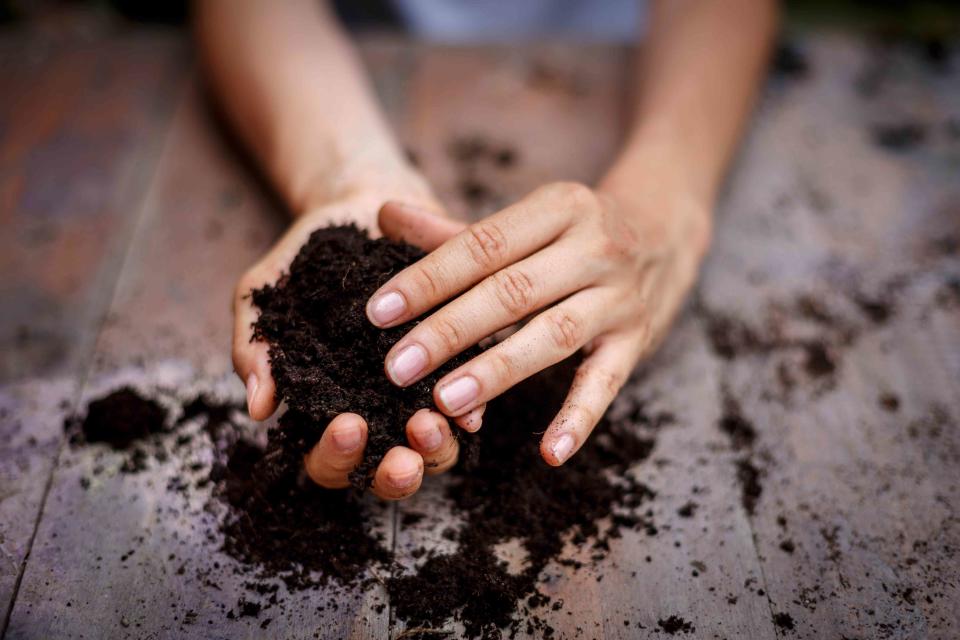How I Make Free Potting Mixes For Seed-Starting and Container Gardening
These DIY potting mix recipes are easy, eco-friendly, and free to make.

Quim Roser / Getty Images
In container gardening, one of the biggest challenges lies in finding the right growing medium for the plants that you wish to grow. Most gardeners will source the potting mix they use from a store.
From an environmental perspective, most commercial potting mixes leave something to be desired. And from a financial perspective, they can be costly, too—especially if you have a lot of pots to fill.
In my opinion, it can therefore be extremely beneficial to think about how you can make your own potting mixes and fill the plant pots in a container garden for free using materials from your very own home and garden.
Many commercial potting mixes contain peat because it retains water well and provides nutrients. But peat comes from peat bogs—unique wetland ecosystems which should not be disturbed. Harvesting peat contributes to the climate crisis and degrades the natural environment, among other things. Read more here: Peat-Free Compost is a Must for Sustainable Gardens.
I always make my own potting mixes for seed-starting and container growing. Though there are many different recipes that you might follow to make your own mixes, below are some details of the methods and materials that I use in my garden.
DIY Seed-Starting Potting Mix
The idea with a seed-starting potting mix is that it should be light and friable, moist yet free-draining. Unlike potting mixes used to grow plants for some period of time, seed-starting mixes do not need to be rich in nutrients.
To start my seeds, I use a mixture of:
1 part (by volume) leaf mold
1 part sieved and light homemade compost
Many gardeners will add perlite to this mix, but I prefer to avoid this mixed material and find that the compost/leaf mold mix is light enough for the seeds I wish to sow without this addition.
Related:How I Make Leaf Mold for My Garden
DIY General Purpose Soil-Based Potting Mix
To fill containers, I often use a soil-based or loam-based general-purpose potting mix, which avoids the need to purchase environmentally damaging peat-based composts, or having to shell out for peat-free ones.
The recipe is very simple:
1 part (by volume) homemade compost
1 part homemade leaf mold
1 part loam/sieved garden soil
I tend to take the soil from molehills that naturally arise in my garden, and leave this for any weed seeds to germinate. I then remove these weeds and use the soil in making this potting mix. If you plan on removing any areas of turf, these might also be stacked upside down to create a good quality loam for container potting mixes.
If fungal pathogens become an issue where you live, then you might consider sterilizing the soil by solarizing it in a hot and sunny place in black plastic, or even by heating it in an oven or stove. But I do not find this step necessary, and when moisture levels are right, there is not often a problem.
Natural soil organisms are beneficial rather than problematic more often than not. And it can be beneficial to include soil or loam, where possible, in potting mixes for plants that will remain in containers over longer periods of time.
Related:How to Compost at Home
DIY General Purpose Soil-Free Potting Mix
If you do not have a source of loam or healthy garden soil, then you might also consider making a soil-free potting mix.
I have success with this simple ratio:
2 parts homemade compost
1 part leaf mold
This can be used for growing a wide range of annual crops in containers and for growing in containers when the plants will not remain in there over the longer term.
Of course, these are just general recipes and can be tweaked to meet the differing needs of specific plants that you might wish to grow in containers.
But as you can see, I need only two main ingredients to make mixes to successfully grow a wide range of different plants in containers: homemade compost and homemade leaf mold. Often, potting mixes can be over-complicated and contain ingredients that plants do not really need.
So, if you want to fill plant pots in a container garden for free, as well as make your own medium for seed starting, I recommend making sure you have systems to make good quality compost and leaf mold in place.
Finally, it is worthwhile remembering that with larger containers, planters, or raised beds, you do not need to fill the entire thing with your potting mix. Instead, you can layer organic materials, like a lasagna, within them. Twigs and sticks on the bottom, then layers of brown and green materials as you would in a composting system.

